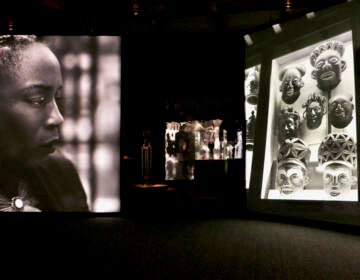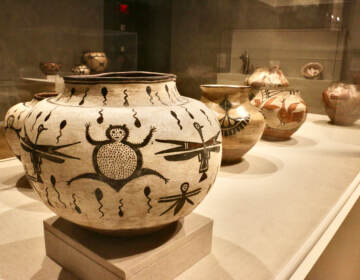I love you, I hate you: Renoir edition
Audiences love to hate art by Renoir. The Barnes Foundation offers a rebuttal.
Listen 5:33
The west wall of Room 13 at the Barnes Foundation features an array of paintings by Pierre-Auguste Renoir. (Courtesy of the Barnes Foundation)
The Barnes Foundation in Philadelphia now has a exhibition of work by Pierre-Auguste Renoir and the filmmaker Jean Renoir. The elder Renoir — considered one of the architects of impressionism — begat the younger, considered the father of French cinema.
The Barnes galleries feature 181 paintings by Renoir, all on permanent display (save one, a lithograph). Together, they form a cornerstone of the world-renowned collection.
A lot of people don’t like Renoir. Some find the flesh tones jarringly pink and green, seeing the bodies — mostly women’s bodies — as variations of putrid.
Others see Renoir’s colors as sickly sweet.
“There are lots of food metaphors when people dismiss Renoir,” said Martha Lucy, deputy director of research and education at the Barnes, who likes to note visitor reactions in the galleries. “People will say, ‘His work looks like cream puffs,’ or ‘It’s like frosting,’ or ‘These nudes look like croissants.’
“They don’t really look like cream puffs. It tells you people associate Renoir with pleasure,” she said. “They are caloric and sweet and sugary. Sweet and sugary does not suggest serious art. If you are a serious consumer of art, that’s not fashionable.”
As part of the new exhibition, “Renoir: Father and Son/Painting and Cinema,” Lucy is acknowledging the Renoir backlash by offering a lecture this weekend, “Why We Love To Hate Renoir.”
She wrote the talk several years ago when preparing the museum’s Renoir catalogue for publication and has delivered it a few times since. Recently, however, Renoir haters have stepped up: in 2015, demonstrators took to the street in Boston and New York – complete with placards and chants – protesting Renoir’s paintings in prominent museums.
In 2010, it even made a headline in the nation’s pre-eminent comic news source, The Onion: “Art World Relieved As Thieves Steal Pretty Terrible Late Period Renoir Work.”
These expressions are laced with irony, of course, but Lucy can’t help but notice they describe a real, underlying distaste.
“At first it was upsetting to me because, here I was writing this book about Renoir, and I’ve chosen to go this direction as an art historian, and I’m thinking this is career suicide,” she said. “Then I realized, it was kind of fascinating.”
Lucy started writing down things overheard in the Barnes galleries. She is quick to point out that plenty of people like Renoir, but the naysayers tend to be more colorful.
In his day, Renoir was extremely popular. Most viewers saw his images as unabashedly pretty. He was also an artist’s artist, a masterful colorist with sophisticated techniques. Renoir’s importance to impressionism is what attracted very serious and determined collectors, such as Albert Barnes.
“His paintings are more complicated than people realize,” said Lucy. “There’s a lot to grapple with there. There are these very bizarre distortions of the body, where he’s playing with perspective and twisting limbs around that anticipate Picasso.”
Since his death in 1919, at age 78, the reception of his work has had its ups and downs. Part of the backlash may be changing attitudes about art and, in particular, women. Many of his nudes — he painted more than his fair share of them — tend to be thick and sensual. There’s a fleshy indulgence on display, which can irritate contemporary audiences.
The austerity of minimalism and the intellectual requirements of conceptualism do not include corpulent pink ladies resplendent in overgrown gardens.
But the pendulum of popular taste will likely swing back to Renoir.
“He’s all about excess and sensuality. He’s engaging all the senses in his paintings,” said Lucy. “As soon an interest in excess and sensuality comes back in art – and I think it is coming back – people will start looking at Renoir differently.”
WHYY is your source for fact-based, in-depth journalism and information. As a nonprofit organization, we rely on financial support from readers like you. Please give today.





